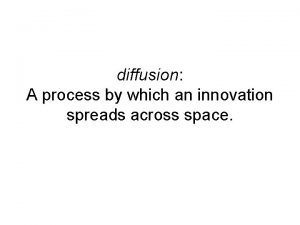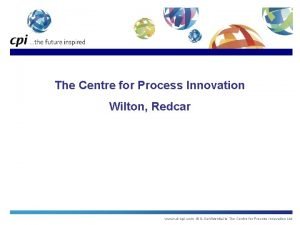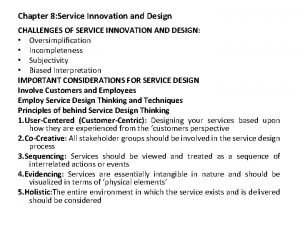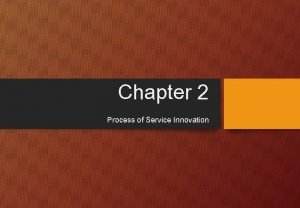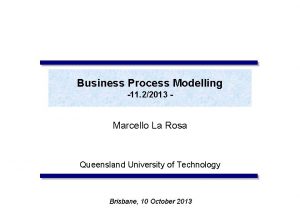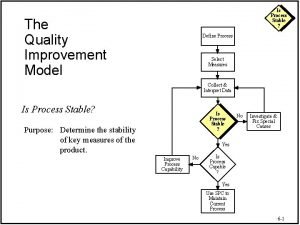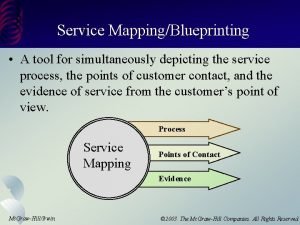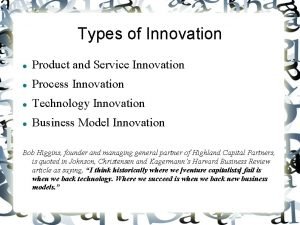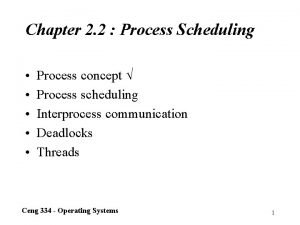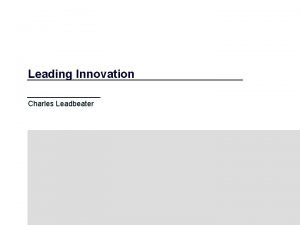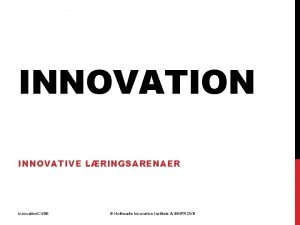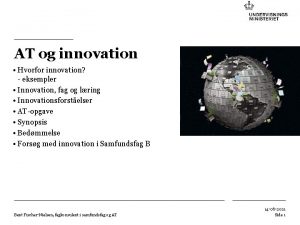Chapter 2 Process of Service Innovation Service Innovation


























- Slides: 26

Chapter 2 Process of Service Innovation

Service Innovation Process • Definition: A service innovation process is the process through which the renewals described are achieved (Toivonen & Tuominen, 2006). • The way to implement service innovation should vary according to the industry (Enz, 2012).

The Dynamic and Systemic Process of Service Innovation (Randhawa& Scerri, 2015) • Service design and new service development • Open and collaborative processes of service innovation • Customer as a co-creator of service innovation • Systemic diffusion of innovation through service value networks

Service Design and New Service Development • Service innovation is delivered through the process of new service development (NSD) that encompasses stages from idea generation to market launch of new service offerings (Goldstein et al. , 2002). • In developing a new service, attention needs to be paid not only to designing the core service features and attributes, but also to the service delivery processes that augment the value for its consumers (Papastathopoulou et al. , 2001; Trott 2012).

Service Design and New Service Development • Service providers can exploit customer differences rather than continually focusing on customer similarities in seeking a variety of ideas and inputs for service innovation (Venkatesh et al. , 2010). • Customers providing input into the service design and delivery process extend the notion of co-production to co-creation of services (Lusch et al. , 2009; Sampson and Chase 2010). • Exploring new ways of determining how services can be tailored (involve customers from all backgrounds), delivered equitably (treat customers fairly) and personalized (provide customers with a choice) in order to present opportunities for innovation.

Open and Collaborative Processes of Service Innovation • This process of open collaboration encompasses a dynamic knowledge exchange across all value network entities to synergise internal and external resources for innovation (Prahalad and Ramaswamy, 2004; von Hippel, 2005; Lusch et al. , 2007). • Russo-Spena and Mele (2012) developed a process of five ‘co-s’: co-ideation, co-valuation, co-design, co-test and co-launch, through which the network lead users, customers, partners and intermediaries coinnovate.

Open and Collaborative Processes of Service Innovation • Chesbrough (2011) refers to two types of openness in the open service innovation model: • 1. outside in - firms incorporate external ideas and technologies within their business • 2. inside out - firms open their ideas and technologies for other businesses to use

Open and Collaborative Processes of Service Innovation • The collaborative and distributed processes of open service innovation that combine ideas, knowledge, and resources among a network of actors can be challenging as it calls for a balance between multiple aspects such as: • (1) identification of the rationale for co-innovation • (2) coordination of the processes and mechanisms of co-innovation • (3) maintenance of policies to deal with conflicts between collaborating entities • (4) maintenance of service quality and consistency

Open and Collaborative Processes of Service Innovation • One effective way of embracing the open and collaborative processes of service innovation is through the approach of design thinking • Design thinking, primarily based on the principles, tools and models that have long served the design function, are being increasingly used by businesses and institutions to find radically new solutions to complex service issues such as the provision of lowcost healthcare services (Bessant and Maher, 2009).

Customer as a Co-creator of Service Innovation • Service innovation is centered on dynamic and relational interactions between suppliers and customers, with customers being regarded as cocreators of innovation through these interactions (Chesbrough 2011; Moeller et al. , 2008; Edvardsson et al. , 2010). • The role of customers is extended to innovators, value chain collaborators and resource integrators (Edvardsson et al. , 2011; Vargo et al. , 2008). • Customer feedback and involvement is critical for codesign and co-development of services (Franke and Shah 2003; Piller et al. , 2004).

Customer as a Co-creator of Service Innovation • Nambisan (2002) suggests that customers can be involved in the innovation process in three different ways—as a resource, as co-producers and as users. • Customers also play active roles as users of new service offerings (Randhawa& Scerri, 2015) • It is also important to engage lead users across all stages of service innovation rather than just at the end of the process (Athanassopoulou and Johne 2004).

Systemic Diffusion of Innovation Through Service Value Networks • Connections through the networks may be human to human, technical to technical or human to technical; highlighting the importance of both human-centricity and technology in service innovation. • Service innovation across value networks are thus far from being a linear transactional process; rather they are a multidimensional systemic phenomenon involving relational interactions between the network entities that result in the co-creation of innovation. (Randhawa & Scerri, 2015)

‘Stages of change’ models: a five-stage process to understand how innovation is spread • Stage 1 Knowledge stage comprehension of knowledge or skill for effective adoption of innovation • Stage 2 Persuasion stage contemplation on new behavior required for adopting innovation • Stage 3 Decision stage preparation to try the innovation • Stage 4 Implementation stage action required for continued use of innovation • Stage 5 Confirmation stage maintenance of the benefits resulting from innovation through integration into ongoing routines

Systemic Diffusion of Innovation Through Service Value Networks • Systemic diffusion of innovation, characterized by the spread and adoption of new ideas and knowledge (Cohen and Levinthal, 1990), is critical to the success of any innovation including service innovation. • In the context of the increasing role of services in today’s economy, studying the service value network as a system that promotes diffusion of service innovation in services is relevant.

Management of Service Innovation • Dynamic capability building for service innovation • Managing organizational knowledge and learning for service innovation • Creating an organizational culture for service innovation • Measurement of service innovation and its outcomes

Dynamic Capability Building for Service Innovation • Dynamic capability building is critical for implementing service innovation, and invokes the organization’s ability to sense, seize and shape opportunities, and to create and reconfigure its resource base (Teece, 2007; Helfat, 2007) in developing and delivering new service offerings. • Agarwal and Selen (2009, 2014) provide empirical evidence that innovation in services is made possible not only through technical capabilities; rather it is the contribution of soft skills such as collaboration and relationship management that enable the realization of such innovation.

Dynamic Capability Building for Service Innovation • For de Brentani (2001), other than service-design and delivery factors, the strategic alignment between organizational resources and capabilities and the new service offerings is a critical aspect of service innovation strategy.

Dimensional framework for service innovation strategy (den Hertog et al. , 2010) • 1. signalling user needs and promising technological options—identifying unmet user needs, dominant trends and new technology configurations • 2. conceptualizing—codifying the fuzzy types of service innovations by creating service blueprints • 3. (un-)bundling capability—making smart service combinations; • 4. co-producing and orchestrating—organizing and acting in open service systems • 5. scaling and stretching—diffusing service innovation through branding and communicating service offerings

Dynamic Capability Building for Service Innovation • Through collaboration between customers, suppliers, and other stakeholders that aids a co-evolutionary process of organizational learning and dynamic capability building, organizations can launch a variety of competitive actions to innovate services.

Managing Organizational Knowledge and Learning for Service Innovation • Organizations need to develop systems and processes for managing the knowledge exchange between the human and non-human entities, integrating knowledge from past innovation projects to current knowledge (De Luca and Atuahene-Gima, 2007; Zahra and Nielsen 2002), and co-evolving their knowledge base toward generating new ideas on an ongoing basis (Lam, 2005; Storey and Kahn, 2010)

Managing Organizational Knowledge and Learning for Service Innovation • Managing organizational knowledge is viewed as a key driving force behind any kind of innovation (von Hippel, 1978; Nelson and Winter, 1982; Malerba, 2005). Organizational learning achieved through learning-bydoing (Nonaka, 1991; Nonaka and Toyama, 2005), experimentation (Schrange, 2000; Thomke, 2003), knowledge sharing (Lin and Wu 2010; Otto, 2012), codification of knowledge (Zollo and Winter, 2002; Nonaka and Takeuchi, 1995), and absorptive capacity (Cohen and Levinthal, 1990) is critical to knowledge creation, which in turn drives innovation.

Creating an Organizational Culture for Service Innovation • The role of organizational culture as a driver of service innovation is being increasingly recognized (Boedker et al. , 2011; Alam, 2010). • Service innovation is affected by the socio-cultural dynamics such as norms, values and ethical standards of all actors that form part of the innovation system (Edvardsson et al. , 2011), and the co-evolutionary social and political interactions that occur between them.

Creating an Organizational Culture for Service Innovation • A culture suited to service innovation promotes Research & Development (R&D) investment for both service product and process innovation, with an equal focus on achieving effectiveness through identifying customer target markets and efficiency by streamlining the supplier base (Bessant and Tidd, 2007).

Measurement of Service Innovation and Its Outcomes • Measurement of service innovation is critical for effective management. • The approaches are required for evaluating and measuring these intangible innovation-related activities in services. • External forces linked with institutional, regulatory and market competition dimensions are also key aspects to be included in the measurement of service innovation (Lee et al. , 2009)

Measurement of Service Innovation and Its Outcomes • Studies have since moved to examining innovation activities as outputs. • For example R&D investment, training, technology adoption and sales of products to new markets are seen as the successful outcomes from innovative efforts (Hall et al. , 2009). • Studies linking innovation, in particular service innovation, to firm-level and economic productivity and growth is currently sparse.

Conclusion • Service innovations is “the interdisciplinary nature of service, integrating technology, business, social and client (demand) innovations”. (Spohrer and Maglio, 2008) • den Hertog (2000) proposes a four‐dimensional model of services innovation. • non‐technological factors in innovation as new service concepts, • client interfaces • service delivery system/organization, • technological options
 Innovation for the sake of innovation
Innovation for the sake of innovation Radical innovation vs disruptive innovation
Radical innovation vs disruptive innovation The innovation process
The innovation process Sustaining vs incremental innovation
Sustaining vs incremental innovation Innovation spreads by the process of
Innovation spreads by the process of Quality and innovation in product and process design
Quality and innovation in product and process design Centre for process innovation limited
Centre for process innovation limited Innovation scout
Innovation scout Challenges of service innovation and design
Challenges of service innovation and design Service innovation definition
Service innovation definition Chapter 13 managing change and innovation
Chapter 13 managing change and innovation Chapter 13 managing change and innovation
Chapter 13 managing change and innovation Os coxae
Os coxae Procedural due process vs substantive due process
Procedural due process vs substantive due process Process hierarchy in process management
Process hierarchy in process management Ergodicity
Ergodicity What is process to process delivery
What is process to process delivery Condylar and coronoid process
Condylar and coronoid process Stable process has to be a capable process
Stable process has to be a capable process Process-to-process delivery
Process-to-process delivery Sweet process review
Sweet process review Sweet evaluation
Sweet evaluation Is a tool for simultaneously depicting the service process
Is a tool for simultaneously depicting the service process Service design process example
Service design process example Service process matrix
Service process matrix Four process strategies in operations management
Four process strategies in operations management Service delivery management definition
Service delivery management definition




